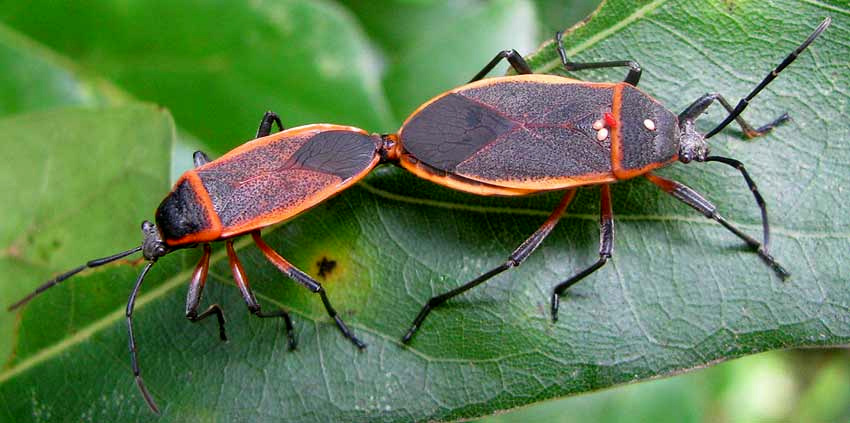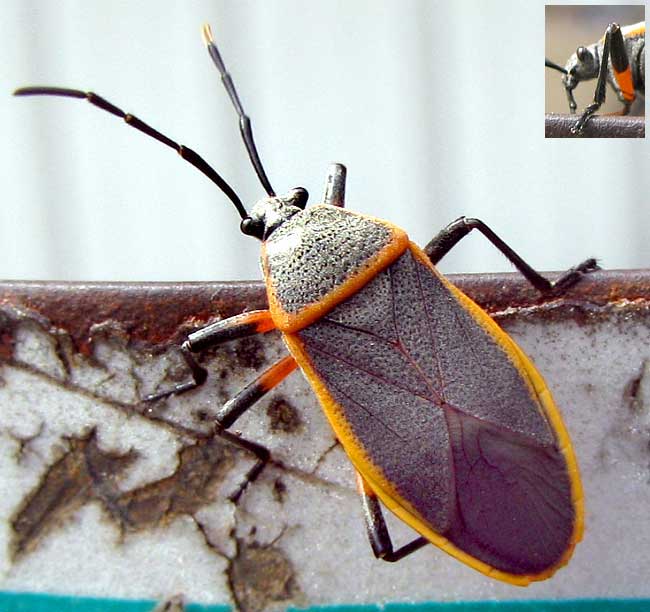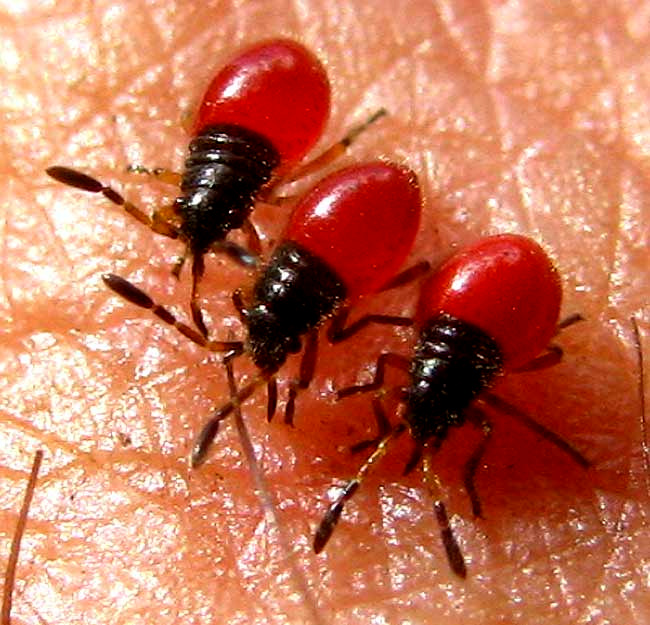Excerpts from Jim Conrad's
Naturalist Newsletter

from the July 22, 2012 Newsletter issued from the woods of the Loess Hill Region a few miles east of Natchez, Mississippi, USA
LARGUS BUG WITH A PASSENGER
For about a month a certain kind of bug has been very conspicuous running across the ground, climbing among low tree branches -- just about wherever plants occur. At first mostly individual bugs were seen but gradually joined-together, mating couples became more common, until about two weeks ago nearly all the bugs seen were mating, as shown above.
These are Largus Bugs, LARGUS SUCCINCTUS. Maybe the most interesting feature of our photo is that atop the larger bug on the right, three tiny, white eggs are visible, as well as a reddish item that must be a newly hatched larva from one of the eggs. Volunteer identifier Bea in Ontario, who figured out that these were Largus Bugs to begin with, on the Internet found pictures of such eggs on Largus Bugs and references to a species of Tachnid fly, genus Trichopoda, who parasitizes Largus Bugs. Tachnid fly species often are used as biological control agents of insects that feed on agricultural and horticultural crops. The adult flies are about the size of an average House Fly. Here is a typical Tachnid fly life cycle:
Females cement eggs to their victim's exteriors, exactly as shown in our photograph. The larvae burrow from the egg directly into the bug's body, with only one larva surviving within each bug. The larva, a maggot, feeds on the living bug, eventually killing it. When the maggot exits the bug's body it drops to the ground and pupates in a dark, reddish-brown puparium. A new generation of adult flies emerges to lay eggs about two weeks later. Each female fly may lay several hundred eggs, and there may be three generations each year, depending on location.
So, we're witnessing a little tragedy here: Presuming the larger, parasitized bug on the right to be the female, which is usually the case, it seems that despite her success in mating, her future as a mother is in doubt.

from the October 11, 2009 Newsletter, an On-the-Road Edition:
LARGUS BUGS
Having left Oregon on Monday afternoon, finally I crossed the Mississippi River into Mississippi on Thursday afternoon. At the Vicksburg Greyhound station I had a 3½-hour wait for the daily southbound bus. The wait was OK, though. It was in the lower 90s, the air was silky-humid, and after a rainless summer dry- season in Oregon, Vicksburg's green lushness was wonderful.
The station was a small one and several bugs of a certain kind were clustering around its trash barrel and door. You can see one above.
I'd been thinking of Mexico and this bug was vaguely similar to the Chagas-Disease-spreading Chinche Hocicona bug I've run into in the Yucatan, so I wondered if this might be an interesting find.
When later I had internet connection, Bea, my bug expert in Ontario, quickly dispelled that notion. It was a "Largus Bug," a member of the genus LARGUS, probably Largus succinctus, in the "True Bug" insect order, the Hemiptera, so this was one time it was perfectly accurate to refer to an insect as "a bug."
Largus Bugs are general feeders, never inserting their strawlike proboscises into human skin, but rather sucking juices from a variety of plants such as oak, wax myrtle and other woodland foliage or even "weeds." In general they cause little injury to the plants upon which they feed.
So, why were they so abundant that day around the Vicksburg Greyhound Station? I read that "... in the fall nymphs and adults leave their host plants and seek cracks and crevices in which to spend the winter. They can be common around the home during the fall, crawling randomly around the ground."
So, last Thursday up at Vicksburg, despite the hot, summery afternoon, the Largus Bugs were sensing fall in the air, were looking for nooks and crannies in which to overwinter, and the Vicksburg Greyhound Station apparently showed some possibilities for a lot of them!
from the August 5, 2012 Newsletter issued from the woods of the Loess Hill Region a few miles east of Natchez, Mississippi, USA
DIET-CHANGING LARGUS BUG NYMPHS
Nowadays you seldom see a Largus Bug, and maybe that helps explain why I didn't think about them the other day when I had an armload of pears picked from the orchard's grass and suddenly my arms and the backs of my hands starting itching as if tiny ants were gnawing on them. Numerous little red and black items hardly larger than aphids were escaping from holes in the pears and spreading all over me. Some looked as if they had their strawlike proboscises stuck into my weather-wrinkled skin busily pumping my bodily fluids into their plump little bodies, as shown below:

The holes in my pears had been pecked by woodpeckers. When the pears drop, yellowjackets, carpenter bees, ants and other insects enter the holes to feast, often overnighting there. My little skin suckers must have been sucking pear juice, and now they were sucking my juices! I can't recall such flexible dietary habits in any insect, but there you have it.
Once I had the above image on my computer screen and could see the critters' strawlike proboscises, four-segmented antennae and general features I recognized that I had wingless nymphs of some kind of "true bug," but still I couldn't imagine what they were. Only when I began reviewing the insect species that have been most conspicuous here lately did it dawn on me to check out what Largus Bug nymphs look like, and then, bingo.
On the Internet many pages speak of Largus nymphs sucking juices from a wide variety of plants -- rarely damaging the plants -- but I can find no reference to them inserting their beaks into humans. Some pages specifically say that the adults don't "bite" humans. Now we know that at least the immature nymphs are more catholic in their cuisine than the adults.